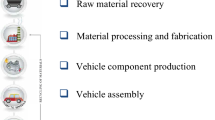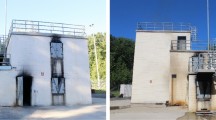Abstract
Nonfatal injuries from slips, trips, and falls (STF) that occur at surface mines can result from inadequate lighting. Mobile equipment operators are among the occupations associated with the nonfatal incidents reported to the U.S. Mine Safety and Health Administration (MSHA). In addition, getting on/off the equipment (ingress/egress) frequently adds to the highest proportion of nonfatal incidents. Accordingly, researchers at the Pittsburgh Mining Research Division (PMRD), National Institute for Occupational Safety and Health (NIOSH) conducted a field study to investigate lighting on haul trucks and wheel loaders with regard to glare and illuminance levels recommended by the Illuminating Engineering Society (IES). The objective was to determine whether two light-emitting diode (LED) area luminaires—a Mr. Beams® (model MB390 Ultrabright) (area luminaire-1) and a NIOSH-developed Saturn (custom-designed for a mine roof bolter study) (area luminaire-2)—could complement a headlamp luminaire. Measured levels of visual tasks, with the headlamp alone and the area luminaires plus the headlamp, demonstrated that illuminance met or exceeded IES-recommended levels. Nevertheless, the area luminaires illuminated a much broader area, which is key to increasing hazard awareness. Discomfort and disability glare were lower with area luminaire-1 than with area luminaire-2. Differences in glare were more noticeable for newer models of haul trucks and loaders featuring updated ingress/egress system designs. This study demonstrates that commercially available luminaires, such as area luminaire-1, are capable of complementing headlamp lighting, and can thus improve a miner’s ability to detect and avoid STF hazards.













Similar content being viewed by others
References
Nasarwanji MF, Pollard J, Porter W (2018) An analysis of injuries to front-end loader operators during ingress and egress. Int J Ind Ergon 65:84–92
Nasarwanji MF, Sun K (2019) Burden associated with nonfatal slip and fall injuries in the surface stone, sand, and gravel mining industry. Saf Sci 120:625–635
Mine Safety and Health Administration (2015-2017) Mining Industry Accident. Injuries, Employment, and Production Statistics and Reports. Retrieved from http://www.cdc.gov/niosh/mining/data/default.html
Pollard J, Kosmoski C, Porter W, Kocher L, Whitson A, Nasarwanji MF (2019) Operators’ Views of Mobile Equipment Ingress and Egress Safety. International Journal of Industrial Ergonomics, Vol. 72, July, p 272-280
Sammarco JJ, Mayton AG, Lutz T, Gallagher S (2009) Evaluation of glare for incandescent and LED miner cap lamps in mesopic conditions. Min Eng 61(6):99–106
Sammarco JJ, Mayton AG, Lutz T, Gallagher S (2011) Discomfort glare comparison for various LED cap lamps. IEEE Transactions of the Industry Applications Society 47(3):1168–1174
Reyes M, Gallagher S, Sammarco JJ (2013) Evaluation of visual performance when using incandescent, fluorescent, and LED machine lights in mesopic conditions. IEEE Trans Ind Appl 49(5):1992–1999
Sammarco JJ (2018) NIOSH Saturn Area Light. Available from:https://www.cdc.gov/niosh/mining/content/saturnarealight.html
Sammarco JJ, Macdonald BD, Demich B, Rubinstein EN, Martell MM (2018) LED Lighting for Improving Trip Object Detection for a Walk-thru Roof Bolter. Lighting Research & Technology, p 1–17
Sammarco JJ, Mayton AG, Rubinstein EN (2020) LED Area Lighting to Reduce Glare for Roof Bolter Operators. Mining, Metallurgy & Exploration (MME) Journal, 37, 851-860
Mayton AG, Nasarwanji MF (2020) Let There Be Light. Pit & Quarry, Feb., p 100, 102, 104
Kaufman JE (ed) (1981) IES Lighting Handbook. Application Volume, pp. 2–5, 2–14, Illuminating Engineering Society (IES), New York, NY
DiLaura DL, Houser KW, Mistrick RG, Steffy GR (eds) (2011) The Lighting Handbook, 10th edition, Reference and Application
Mayton AG (1991) Investigation of Task Illumination for Surface Coal Mining Equipment Operators. Journal of the Illuminating Engineering Society, 1991, Vol. 20, No. 1, Winter Edition, pp 2–18
De Boer J (1967) Visual perception in road traffic and the field of vision of the motorist. Public Lighting 1967:11–96
Bullough JD, Brons JA, Qi R, Rea MS (2008) Predicting discomfort glare from outdoor lighting installations. Light Res Technol 40(3):225–242
Rea MS IES Lighting Handbook, 8th Edition, Reference and Application Volume. 1993: Illuminating Engineering Society of North America
Acknowledgements
The authors thank Dan Wible of Allegheny Mineral for providing the field site and access to the equipment at the limestone operation used in this study. We also appreciate the contributions of Mary Ellen Nelson for her support and assistance in the development of mounting brackets for the luminaires and instrumentation.
Author information
Authors and Affiliations
Corresponding author
Ethics declarations
Conflict of Interest
The authors declare no potential conflicts of interest with respect to the research, authorship, and/or publication of this article. The mention of any company or product does not constitute endorsement by NIOSH. The findings and conclusions in this paper are those of the authors and do not necessarily represent the official position of the National Institute for Occupational Safety and Health, Centers for Disease Control and Prevention.
Additional information
Publisher’s Note
Springer Nature remains neutral with regard to jurisdictional claims in published maps and institutional affiliations.
Appendix
Appendix
1.1 Definition of terms
-
1.
Luminaire: a complete lighting unit consisting of a lamp or lamps together with the parts designed to distribute the light, to position and protect the lamps, and to connect the lamps to the power supply.
-
2.
Luminance: light the eye sees that is directed from a surface.
-
3.
Illuminance: light that strikes a surface.
-
4.
Veiling luminance (also disability glare): a luminance superimposed on the retinal image that reduces its contrast. The veiling effect produced by bright sources or areas in the visual field results in decreased visual performance and visibility.
-
5.
Veiling reflection: regular reflection, superimposed upon diffuse reflection from an object, that partially or totally obscures the details to be seen by the reducing the contrast (sometimes called reflected glare).
-
6.
Discomfort glare: glare producing discomfort that does not necessarily interfere with visual performance or visibility. Also described as an annoying sensation, causing pain in extreme cases, that results from high or non-uniform distribution of brightness in the field of view.
-
7.
Disability glare: the glare that results in reduced visual performance and visual ability caused by the action of stray light that enters the eye and produces a scattering effect within.
-
8.
Nit: a unit of luminance equal to 1 cd/m2.
-
9.
Lux: the unit of measure of illuminance. One lux is 1 lm/m2.
-
10.
Luminous flux: the time rate of flow of light.
-
11.
Luminous intensity: the luminous flux per unit solid angle in the direction of interest.
-
12.
Candela: the SI unit of luminous intensity. One candela is 1 lm/sr.
Rights and permissions
About this article
Cite this article
Mayton, A.G., Demich, B. & Nasarwanji, M.F. Investigation of Machine-Mounted Area Lighting to Reduce Risk of Injury from Slips-Trips-Falls for Operators of Mobile Surface Mining Equipment. Mining, Metallurgy & Exploration 37, 1919–1930 (2020). https://doi.org/10.1007/s42461-020-00239-0
Received:
Accepted:
Published:
Issue Date:
DOI: https://doi.org/10.1007/s42461-020-00239-0




